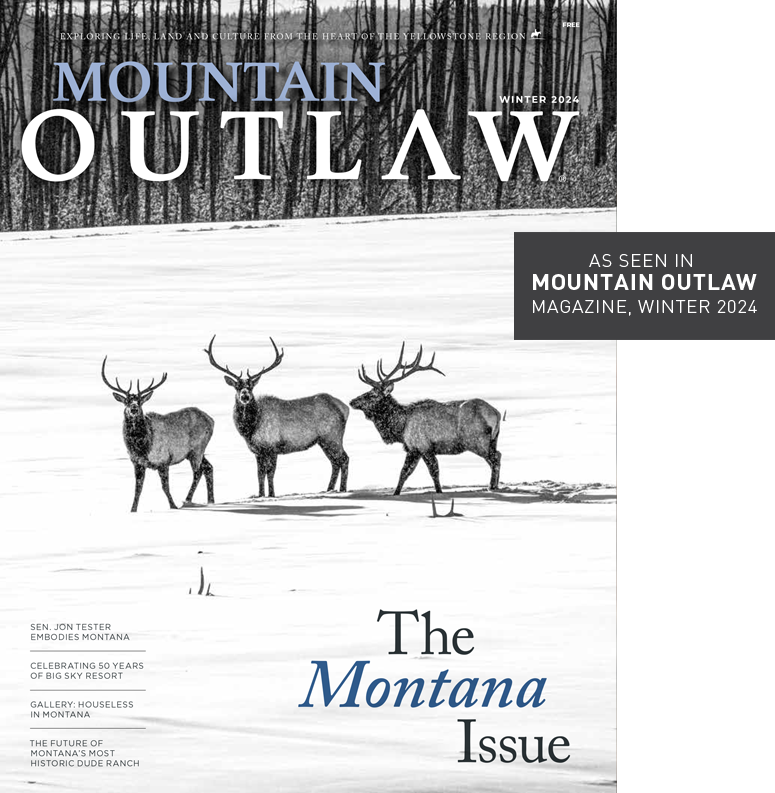One Montana mom and pop ski area is keeping its focus on the simple joy of skiing.
BY SAMI BIERMAN
The wooden lodge at the base at Maverick Mountain came into view as my snowboard glided downhill, the nose of my board invisible beneath 2 feet of fresh powder. It was January, and my first time visiting this quaint southwest Montana ski area. Everything about the trip felt like a pleasant surprise, quenching my desire for a ski experience I didn’t even know existed. Thanks to a recent storm, the timing couldn’t have been more perfect. It was a welcome reunion with the Montana cold smoke I grew up on—though that’s not the only thing that felt reminiscent of the past.
When I pulled into the parking lot, I was shocked to find a spot right at the base, and I walked straight into the lift line. There was only one chairlift, ensuring a guaranteed pace of skiers enjoying what felt like endless, knee-deep powder. The lift line was a place of snowy smiles, rosy cheeks, and friendly banter between old friends. Occasional whoops and hollers erupted as skiers descended the last pitch of snow before the base. From the moment I arrived at the mountain, the energy of what was being built (and what was being preserved), was apparent. I’d read stories about the trend toward consolidation and corporatization in the ski industry, but I had yet to experience the magic of what was being lost.
This winter will be Erik and Kristi Borge’s ninth season of owning and operating Maverick after purchasing the mountain from Randy Shilling in 2015. Hidden in the Beaverhead- Deerlodge National Forest, Maverick offers 425 acres of terrain to skiers of all levels. The Borges view themselves as caretakers of the mountain. But what they are protecting is much more than a nostalgic charm of what skiing used to be like; they are actively helping maintain the sport as accessible and integral to the surrounding community.
Erik asserts that small hills are the ones creating the future generations of skiers. Given the cost-prohibitive nature of lift tickets at most large resorts, Erik recognizes that for a family of four to try skiing for one day requires “a crazy amount of money,” he said. “We’re the ones that are creating future skiers for the big mountains.”
Maverick offers extensive school programming to the youth of Beaverhead County, teaching roughly 350 kids each year how to ski. And this season, to further increase the accessibility of the sport for beginners, Borge hopes to offer a free pass for their new Sun Kit Conveyor.
Rather than competing with larger resorts, Borge actually feels that the big conglomerates are “strengthening the small ski market.” As the big ski corporations continue to grow, he says, “people often find themselves seeking out small ski areas, mom-and-pop type of operations.”
This trend can be seen in the clientele that visits Maverick each winter. Borge explains how today’s Maverick skiers are a mix of local community members from Beaverhead County, and visitors from regional areas such as Bozeman, Butte, Missoula and Helena. “There’s definitely an influx of people that are coming because they wanna go back in time and go skiing how it used to be. They don’t wanna fight in lines. They don’t wanna pay crazy amounts of money for tickets, or they can’t pay crazy amounts of money for tickets.”
But despite the important role these small hills play in addressing access barriers for beginner and low-income patrons, mountains like Maverick face big challenges to keep their lifts open and operating. One example is how expensive the insurance is, despite being a small hill. Erik shared that this year his insurance quote came in five times the amount as last year, for the same coverage. “Every time another ski area gets bought up, they get pulled out of the insurance pool, so there’s less and less ski areas needing insurance. It’s definitely been affecting rates,” he said.
Another harsh reality is operating in an industry inherently reliant on snow in the face of climate change.
“I think we can all agree that the weather’s changing and that is definitely a hurdle or a worry for the future,” Erik said. “I hope that we have snow for our kids to ski and their kids to ski, for generations to come.”
Throughout our conversation, I was struck by Erik’s optimism and sense of resilience, and I realized that maybe that’s just what it takes. A true ski bum at heart, it seems that Erik is working toward a definition of success that is otherwise unconventional by today’s standards. I consider the definition of the word maverick: an unorthodox or independent-minded person.
“There’s a number of different ways that success looks like for me. In one of the simplest forms, when I come to the lodge on any given day and I see a whole bunch of people with smiling faces talking about how great the skiing is; to me, that’s success,” he said. “I’m not gonna get rich doing this. I never will. I’ve accepted that. But I didn’t come for money. I’ve never really placed a lot of value on a dollar. Certainly, there’s things that are nice, but for me, being able to live the lifestyle that I get to live and raise my family in the lifestyle that we’re living is success to me too.”
In today’s world, I can’t think of a better sentiment to embody the spirit of a maverick.
Born and raised in Bozeman, Montana, Sami Bierman found her passion for playing in the outdoors and exploring wild spaces at an early age. As a wilderness guide, artist, and writer, she is interested in exploring topics of access, equity, and connection with the natural world.

